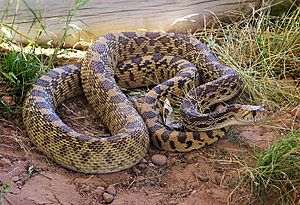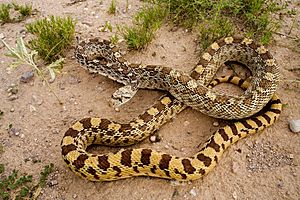Gopher Snake facts for kids
Quick facts for kids Pacific gopher snake |
|
|---|---|
 |
|
| Conservation status | |
| Scientific classification | |
| Genus: |
Pituophis
|
| Species: |
catenifer
|
| Synonyms | |
|
|
Pituophis catenifer is a species of nonvenomous colubrid snake endemic to North America. Nine subspecies are currently recognized, including the nominotypical subspecies, Pituophis catenifer catenifer, described here. This snake is often mistaken for the prairie rattlesnake, but can be easily distinguished from a rattlesnake by the lack of black and white banding on its tail and by the shape of its head, which is narrower than a rattlesnake's.
Contents
Etymology
The specific name, catenifer, is Latin for "chain-bearing", referring to the dorsal color pattern.
Description
Adults are 36-84 in (91–213 cm) in length. Dorsally, they are yellowish or pale brown, with a series of large, dark brown or black blotches, and smaller, dark spots on the sides. Ventrally, they are yellowish, either uniform or with brown markings. They also come in several morphs depending on the subspecies.
Behavior
The gopher snake has a unique defensive mechanism, in which it puffs up its body and curls itself into the classic strike pose of a rattlesnake. However, rather than delivering an open-mouthed strike, the gopher snake often strikes with a closed mouth, using its blunt nose to "warn off" possible predators. Additionally, gopher snakes vibrate their tails in a manner similar to rattlesnakes. One paper found that gopher snakes on islands lacking rattlesnakes vibrate their tails for shorter amounts of time than gopher snakes in mainland California, which is home to numerous rattlesnake species. This suggests that gopher snake tail vibration may in fact be rattlesnake mimicry since the behavior appears to be breaking down in areas without rattlesnakes, perhaps because predators on these islands have no reason to evolve to avoid tail-vibrating snakes (rattlesnakes are venomous, gopher snakes are not).
Life expectancy
Wild gopher snakes typically live 12 to 15 years, but the oldest captive recorded lived over 33 years.
Common names
Common names for this species, or its several subspecies, are: Pacific gopher snake, Henry snake, coast gopher snake, bullsnake, Churchill's bullsnake, Oregon bullsnake, Pacific pine snake, western bullsnake, western gopher snake, Sonoran gopher snake, western pine snake, great basin gopher snake, blow snake, and yellow gopher snake.
Subspecies
As of 2022, there is largely agreement on the recognition of six subspecies occurring in Canada, USA, and mainland Mexico. However, there is not agreement among taxonomist on status of populations from Baja California and adjacent islands. The Cape gophersnake (Pituophis catenifer vertebralis) and Central Baja California gophersnake (Pituophis catenifer bimaris) are recognized by some as single species with no subspecies Pituophis vertebralis, or as a species with two subspecies Pituophis v. vertebralis and P. v. bimaris by others. Other subspecies including the Coronado Island gophersnake (Pituophis catenifer coronalis) and San Martin Island gophersnake (Pituophis catenifer fulginatus) are of questionable validity.
| Standardized English name, subspecies, and author | Geographic range |
|---|---|
| Sonoran gophersnake
P. c. affinis Hallowell, 1852 |
Southwest USA including extreme southeast California, Arizona, New Mexico, Trans-Pecos Texas, and northwest Mexico including extreme northeast Baja California, Sonora, Chihuahua, Coahuila, northwest Nuevo León, Sinaloa, eastern Durango, north Zacatecas, and extreme west San Luis Potosi (Chihuahuan Desert and Sonora Desert). |
| San Diego gophersnake
P. c. annectens Baird & Girard, 1853 |
Southwest California and northwest Baja California |
| Pacific gophersnake
P. c. catenifer (Blainville, 1835) |
The United States, from Oregon west of the Cascade Range, south into California, west of the Sierra Nevada to northern Santa Barbara County and the Tehachapi Mountains. |
| Great Basin gophersnake
P. c. deserticola Stejneger, 1893 |
South-central British Columbia, Canada, east Washington, east Oregon, southwest Idaho, southwest Wyoming, Nevada, Utah, west Colorado, parts of southeast California, northern Arizona and extreme northwest New Mexico (Great Basin and Mojave Desert) |
| San Martin Island gophersnake
P. c. fulginatus Klauber, 1946 |
San Martin Island, Baja California |
| Santa Cruz Island gophersnake
P. c. pumilis Klauber, 1946 |
Santa Cruz Island, Santa Rosa Island, and San Miguel Island, California |
| Bullsnake
P. c. sayi (Schlegel, 1837) |
Southern Alberta and Saskatchewan, Canada, central USA including east Colorado, Illinois, extreme northwest Indiana, Iowa, Kansas, Minnesota, Missouri, Montana, Nebraska, east New Mexico, southwest North Dakota, Oklahoma, South Dakota, Texas, southwest Wisconsin, east Wyoming, and northern Mexico including northeast Nuevo León, Tamaulipas, extreme southeast San Luis Potosi, and extreme northern Veracruz (Great Plains and Midwestern United States). |
Images for kids
See also
 In Spanish: Serpiente gopher del Pacífico para niños
In Spanish: Serpiente gopher del Pacífico para niños









